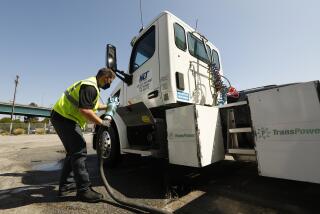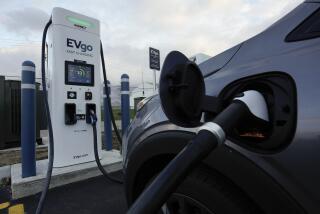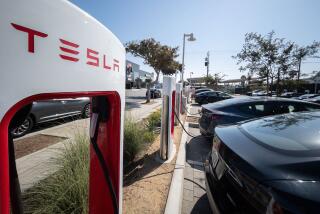What to consider when shopping for an EV or plug-in hybrid
Electric cars are back.
Popular in early automotive history, electrics quickly got smoked by their internal combustion-driven cousins.
But in this age of volatile gas prices and climate worries, these clean, quiet vehicles are winning new fans. Advances in technology have improved their range and power. Companies are rolling them out in every flavor.
Need a small SUV? Take a look at the Toyota RAV4 electric hitting the market next year. How about a luxury sedan? There’s the Fisker Karma plug-in hybrid, which the automaker compares to a Maserati Quattroporte but with better mileage and lower emissions than a Toyota Prius. Do you lean toward small, practical sedans that seat five? The Nissan Leaf may be your ticket.
Although existing offerings and the EVs about to come out are comparable to many conventional gasoline-powered vehicles in virtually every aspect but range, they aren’t for everyone. Here’s what to consider if you are thinking of making an electric vehicle or plug-in hybrid your next drive.
Be prepared to pay more: A glance at the sticker prices says it all. You are going to pay more for the privilege of being able to zip along powered by electrons rather than fossil fuel. The cost of a home charging station adds an expense you don’t have with a gasoline car, but it does add convenience.
When you take the purchase price, add in the cost of three years of maintenance, three years of fuel and a home charging station, then back out the expected resale price, a Chevrolet Volt will run almost $9,000 more than a similar-size conventional-engine Hyundai Elantra and about $5,000 more than the current Prius hybrid before sales taxes and registration fees. A Leaf has a lower sticker price and qualifies for more incentives, depending on the state. It will cost about $6,500 more than an Elantra and about $3,500 more than a Prius before taxes and registration fees. The Leaf’s cost could fall an additional $2,500 if you qualify for California’s rebate for battery electric vehicles.
But California residents would have to add back $700 to $1,000 in expenses for both electric vehicles because they must pay sales taxes on the cost of the vehicles before any tax credits and rebates.
Philosophy or economics: Is it worth the added expense to reduce your dependence on oil? What are you willing to pay to reduce carbon emissions in your neighborhood? The Leaf creates about 1.8 tons of carbon emissions in a year’s driving, or about 13,500 miles, according to federal estimates. A Honda Accord spews 6.2 tons of carbon emissions traveling the same distance. If you can keep a Volt — which has a gas engine to kick in and make electricity when the battery runs out — on mostly electric power, you will put up carbon numbers closer to the Leaf.
Think about your drive: Face it, if you have a mega commute you will be better off in a hybrid or conventional fuel-efficient vehicle.
Motorists who commute about 40 miles or less, or who have easy access to a workplace charging station, will be able to make better use of an EV because they won’t be limited by the shorter range of the vehicles.
But even then, be careful. The Toyota Prius Plug-in Hybrid that goes on sale next year will have an all-electric range of only about 13 miles. After that, the gasoline engine starts. People who drive more than 13 to 15 miles a day might be better off buying a conventional hybrid or fuel-efficient gas-powered car and saving the premium they would pay for the plug-in and the expense of a home charging station.
A Nissan Leaf, and some of its rivals hitting the market in the coming months, will go roughly 75 miles or more on one charge. That’s enough for a longer commute, but because the Leaf, the Ford Focus Electric and similar cars are pure electric vehicles, there’s no backup gas motor to engage and provide a safety net.
Charging into charging: EVs make the most sense for people who can charge at home, and that rules out most apartment and condo dwellers for now. A home charging station is going to set you back about $2,000 and possibly more, depending on the wiring in your home. You will also need to clear out space in your garage to park a car — imagine that!
And you are going to have to research electricity rates. According to the Union of Concerned Scientists, a Leaf owner who drives 13,500 miles annually will pay from $393 to $725 for Los Angeles Department of Water and Power electricity, depending on off-peak or peak charging schedules.
Know the incentives: Electric vehicles on the market and coming models are expected to qualify for the $7,500 federal tax credit. But various state and other incentives beyond that get tricky, and you need to research the appropriate government agency before you buy. Many California Leaf buyers thought they would get a $5,000 state rebate only to discover that the funds ran out. Now they will get $2,500 rebates, and at some point that money is also going to run out.
Buyers of the Volt in California face a different issue. It does not qualify for the state rebate. And unlike owners of the Leaf or even the pricey Tesla Roadster, Volt buyers can’t get that coveted carpool lane permit. Chevrolet plans a mid-2012 model year upgrade that may change the emission profile of the Volt to make it eligible for those perks. Likewise, the first edition of the Fisker Karma also won’t qualify for the state rebate or carpool permit.
And then there’s a question of how long the rebates will exist. California has enough money left for about 5,000 of the $2,500 rebates. The federal tax credit could disappear in a future round of budget cuts.
When to jump in: This is the classic conundrum of all advanced-technology products. Do I buy now or wait for something to come along later? The big issue with electric vehicles and plug-in hybrids is how long you can go before the juice runs out. That’s dependent on the size of the battery and its energy density. Tesla vehicles claim the biggest ranges — around 200 miles. But unless you are a serious eco driver, it’s going to be hard to get even close to 100 miles out of the other vehicles. Plug-in hybrid ranges will be much larger because you will have the gas engine as a backup.
Most automakers believe there will be only small improvements to batteries in the near future. The price will go down as manufacturing volumes increase, but we won’t see a sudden jump that doubles the range of the Leaf or the Focus Electric.
Buyers also need to be concerned about battery life. Theoretically, the batteries have long warranties — eight to 10 years, depending on state regulation and the individual automaker. But they are also expected to degrade, and that will hurt range. It is not clear when an automaker might step in and replace a battery as it degrades.
In the near term, many buyers may decide to lease an electric vehicle instead of making a purchase. That would insure them against issues with performance and the battery. At the end of 36 months, you can hand the car and keys back to the manufacturer and see what new cool EV is on the market. Or by then, maybe you will be ready to check out the first of the hydrogen fuel-cell autos.







